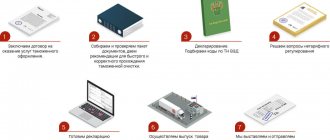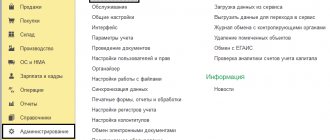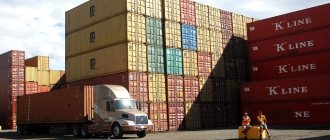Home \ Useful information \ Procedure for customs clearance of goods \ Customs clearance
Customs clearance is a complex of customs operations necessary for the release of goods when exported outside the customs territory. The term “customs clearance” is often used when exporting. It is worth noting that the word “customs clearance” is slang; in documents and business correspondence they write “customs clearance of exports” or simply “customs clearance”.
As a rule, there are four types of customs clearance: customs clearance of automobile cargo, maritime, aviation and railway. Each of these types is unique in its algorithm for carrying out the export customs clearance process.
Documents for customs clearance of goods in export mode. Documents for customs clearance
- List of documentation for registration of an individual at customs ()
- List of documentation for registration of a Legal entity at customs ()
- List of documentation for registration of an individual entrepreneur at customs ()
- List of documentation for customs clearance ()
Official website: https://ucsol.ru/tamozhennye-uslugi/zatamozhka
Customs clearance of air cargo
The first type of customs clearance is customs clearance of goods that will be transported by air. The customs clearance process itself in this case is not so complicated.
To clear air cargo through customs, you need several basic documents - an air waybill and a customs declaration.
One of the main features when clearing air cargo is the ability not to place the cargo at a temporary storage warehouse. To clear cargo through customs without placing it on a temporary storage warehouse, you must weigh it in advance. If the cargo is not weighed in advance, then there is a discrepancy between the documents and the actual weight, then the cargo may be detained for inspection. This may result in unplanned loading costs. The cost of customs clearance for one consignment of cargo departing by air is 23,000 rubles. (for legal entities) and 16,000 rubles (for individuals). Customs clearance is carried out at Moscow airports (Domodedovo, Sheremetyevo, Vnukovo). Customs clearance is carried out under the stamp of a customs broker.
You receive in your hands: - customs declaration; — AWB (air waybill) with customs stamps; - invoice with customs stamps.
Please note that all documents are issued to you with all stamps. If you provide the exact gross weight of the consignment, it is possible to clear customs WITHOUT actually placing the cargo in a temporary storage warehouse (TSW).
Import customs clearance procedure
1 Preparation
2 Filling out the declaration
3Filing a declaration
4Decor
5Delivery to warehouse
Preparation
The main stage of customs clearance is preparatory. Having collected all the data about the product, it is necessary to correctly classify it according to the Commodity Nomenclature of Foreign Economic Activity of the Eurasian Economic Union. They also say “choose the HS code for foreign economic activity.”
It is the HS code that provides information about what specific documents will have to be prepared to release the cargo from customs, and will allow you to calculate customs payments.
In addition to the standard package of commercial and transport documents, declarations of conformity, certificates of conformity, certificates of origin and other papers may be needed.
For example, according to your HS code, customs may require a declaration of conformity, and for this purpose conduct laboratory tests of product samples. To avoid this being a surprise, it is best to consult with an experienced customs broker about the classification of your shipment in advance. Even if you decide to handle customs clearance on your own, you can always contact a broker for the service of selecting a HS code - Meridian will cope with this task in 1 hour and 1000 rubles.
Having decided on the HS code, you can begin collecting and processing the necessary documents and calculating the customs value. It consists of the purchase price and additional costs for delivering the goods: transportation, packaging, storage, loading and unloading and other services. Based on the customs value, rates of duties and taxes according to the Commodity Nomenclature of Foreign Economic Activity code, upcoming customs payments are calculated.
Example:
- Product: textile carpets.
- HS code: 5705008000 - “carpets made of other textile materials”. To select a code, it is important to clarify the material - for carpets made of wool, a different HS code is used.
- Rate according to the HS code: 0.38 euros per square meter
- Total area of carpets: 100 pieces of 10 square meters, total 1000 square meters.
- Duty: 1000 square meters * 0.38 euros = 2600 euros
Filling out the declaration
Document flow with customs authorities occurs in electronic format, therefore both the declaration and related documents are submitted electronically. This can be done through the Personal Account of a foreign trade participant on the website of the Federal Customs Service. The interface there is so inconvenient and ineffective that almost everyone prefers to work with special paid programs, sending data to customs directly from them. The most popular are Alta and VED-Declarant.
In any case, you will have to register on the FCS website to gain access to your Personal Account.
Simultaneously with registration, you will have a Unified Personal Account (USA). It is to this that it is necessary to transfer funds for further payment of customs duties and payments in advance, even before submitting the declaration. We recommend keeping a reserve amount on the ULS to cover possible fluctuations in exchange rates: the amount in rubles will be written off at the exchange rate on the day the declaration is issued, and not on the day the funds are credited to the ULS.
It will also be necessary to issue an electronic signature – an electronic digital signature that is used to endorse the declaration upon submission. If you work with a customs broker, he will use his digital signature.
Arrival of cargo and submission of declaration
When the cargo arrives in Russia, it is placed in a temporary storage warehouse (TSW). Transport is not important, temporary storage warehouses are everywhere. As soon as your shipment arrives at the warehouse, its employees inform customs using the DO-1 form, reporting that they have accepted the goods for storage. After this, you can submit a declaration with the necessary documents.
If your cargo requires veterinary or phytosanitary control, then these procedures must be completed before submitting the declaration.
Checking the submitted declaration
Customs assigns a number to the submitted declaration, which can be used to track its further fate. According to the law, the inspector has 2 working days to check and issue a declaration. If problems arise, the inspector has the right to increase this period to ten days. If the set of documents is prepared correctly, then in practice everything happens faster. Meridian releases cargo on average within 4 hours from the moment the declaration is submitted.
What can happen at this stage:
- will order an inspection (check the cargo, presence and correctness of markings, authenticity of the declaration)
- will request additional documents (a wide range: from a technical description of the product to price lists confirming the declared value)
- will request additional clarifications, photographs, translation of the provided documents into Russian, etc.
While you are busy communicating with customs and collecting documents, the cargo will continue to be stored at the temporary storage warehouse, the services of which are paid separately. If the cargo is perishable, then such delays can be fatal.
Delivery to the importer's warehouse
Once received, the cargo can be picked up from the temporary storage warehouse and disposed of further at your own discretion. In some cases, when some documents are missing, customs releases the cargo “conditionally”. This means that the importer can take the goods from the temporary storage warehouse to his warehouse, but only for storage. The importer will be able to do anything with the goods (repackage, sell to third parties, use, etc.) only after providing the missing documents to customs.
Customs clearance of automobile cargo
Documents for customs clearance of road cargo - customs declaration and CMR
For the fastest customs clearance of automobile cargo, it would be better to contact a customs broker. The main feature is that automobile posts do not require the placement of cargo at a temporary storage warehouse. This means that we clear cargo without placing it on the temporary storage warehouse. Thanks to this, your cargo will not be subject to additional transportation.
It happens when the cargo that needs to be cleared for export to Uzbekistan is in
Omsk. The client always has a choice of how the cargo is cleared through customs, either it can be immediately brought to one of our partners’ temporary storage warehouses close to the customs post, or it can be left in its warehouse and not worry about security checks.
Inspection is an unpleasant process due to the expenditure of resources in the form of time and money. When an inspection occurs during customs clearance, you will be billed from 80,000 to 200,000 rubles at the temporary storage warehouse for unloading and loading services. The unloading and loading process itself takes about 2 days.
A good customs broker will help you avoid inspection during customs clearance. Many people look solely at the cost of services and choose the cheapest cost. Our cost is not the lowest on the market, but our staff of highly qualified specialists eliminates all risks when clearing your cargo through customs.
The cost of customs clearance of one truck or consolidated cargo (batch) departing by road transport is from 15,000 rubles. This is the cost of turnkey export registration - including a temporary storage warehouse. Customs clearance is carried out under the stamp of a customs broker.
You receive in your hands: - customs declaration; — CMR with customs stamps; - invoice with customs stamps.
All specified documents are transferred in Moscow (near Domodedovskaya metro station). The cargo does not need to be placed in a warehouse and brought to customs. During registration there, the cargo is in your warehouse.
When choosing a customs broker, we recommend paying attention not only to the cost of his services, but also to his experience, office and staff.
We are not afraid to tell our clients the specifics of customs clearance of their cargo, because the main thing is that our clients’ cargo is cleared by customs within the specified period, and our specialists will contribute to this.
Features of customs clearance
Customs clearance procedures for goods imported into Russia have a common basis, but may differ in nuances depending on the type of cargo. Let's consider how customs clearance of various categories of transported products occurs?
Dangerous goods
The import of goods belonging to the category of dangerous goods into the Russian Federation has its own specifics of transportation and customs clearance. Dangerous goods that can pose a danger to human life and the environment during transportation, loading and storage are defined by the GOST 19433-88 standard.
Customs clearance of such goods is carried out only at specialized customs posts and temporary storage warehouses. Each batch of goods must have high-quality packaging that prevents leakage, spillage, and detonation.
To register such cargo, special documentation issued by the relevant authorities is provided. The cargo must have 4 main permits:
- expert opinion on the analysis of the composition with information on the percentage of substances;
- expert opinion on cargo safety;
- product characteristics and instructions for its use;
- Hazard class marking on packaging accepted in Russia.
During customs clearance of chemical products, a letter is drawn up containing explanations for the customs authorities. When transporting cargo by sea, you must present an IMO declaration; when transporting by road, you must present an ADR TREM cards (MSDS) safety sheet.
General cargo
The peculiarity of general cargo is a type of product that is transported in one type of packaging/container and, as a rule, on one type of transport - from one sender to one recipient. Transportation of general cargo is carried out by any type of transport - air, sea, rail, road and multimodal.
Customs clearance of general cargo takes place at most customs posts of the Russian Federation and is carried out according to the same scheme as customs clearance of other types of imported products. Cargoes of this type are subject to declaration, as well as customs duties. More details about them can be found in the article “General cargo and their transportation.”
Groupage cargo
Groupage cargo may include any goods that are not prohibited for import into the territory of the Eurasian Economic Union and are not a commercial consignment (not containing a large number of similar goods). Due to the fact that groupage cargo consists of products of different types, customs clearance in these cases is more difficult than usual. In general, the procedure differs from the standard one only in that it is necessary to prepare a package of accompanying documents for each type of groupage cargo transported.
The main problem with customs clearance of groupage cargo is the incorrect description of what is being transported. If at least one of the goods is processed incorrectly, the entire cargo will be delayed, which means that all other recipients whose accompanying documents are in order will suffer. Therefore, each consignor must include the most correct information in the declaration.
Oversized cargo
Large (oversized) are cargoes that exceed the permissible dimensions of transport in any of these parameters: length - 20 m (road train), 12 m (single vehicle); width – 2.55 m; height – 4 m.
The concept of “large cargo” is not used in customs legislation; it is a logistics term. Customs clearance of such cargo is carried out in accordance with the general procedure. The amount of duties on large-sized cargo is determined depending on the HS code of the group to which the declared product belongs.
Customs clearance of sea cargo
International transportation using sea transport is a productive way to deliver various goods over long distances across the planet. Such transportation is in great demand among entrepreneurs bringing goods from Asia, Europe and America. Due to regular progress in trade and economic relations between states, transportation by sea is one of the most important elements of foreign economic activity, and also has many advantages:
- Possibility of transporting any number of groups of goods, regardless of their weight characteristics and volumes.
- Transportation safety - it is usually carried out in specialized twenty- or forty-foot containers.
- Absolutely any goods can be transported in containers - oversized, bulk, prefabricated, liquid and the like.
- Low transportation cost.
The variety of logistics routes increases every year; exporting goods to many countries using sea transport is much cheaper. Based on the cheapness and relevance of this type of transportation, many people have questions about customs clearance of goods for export by sea.
The main document when transporting cargo by sea is a bill of lading; when the cargo is released, this document is stamped “release permitted.” Many customs representatives, when clearing the cargo, give the client a document without the necessary stamps, because of this there may be problems at the customs of the country of the buyer of the cargo. In this case, the customs broker made a mistake and is unlikely to admit it. Often in such situations, customs brokers refer to the act of electronic declaration and completed customs clearance. To avoid such situations, our specialists always hand over stamped .
Benefits of Professional Help
Our employees have extensive experience in successfully processing both imported and exported products. We know exactly how to make customs clearance as painless and quick a procedure as possible. Call the company's managers to find out the exact cost of the service and get advice. The final amount depends on the characteristics of the cargo, the location of customs clearance, the type of transport, the volume of the shipment and other characteristics. However, we can guarantee reasonable prices for customs clearance while providing high quality services.
Our company is a customs broker with a valid license. We check and prepare documents, represent the client’s interests when crossing the border, and interact with representatives of regulatory authorities. Extensive experience and knowledge of all the nuances of the procedure allows you to go through customs without problems and delays and remove the cargo from the country for the purpose of its further sale.
Customs clearance of railway cargo
Sending commercial cargo by rail requires not only the organization of competent transportation, but also customs clearance as quickly as possible. The customs clearance process for railway cargo takes place in 1 day. The main document for the export of railway cargo is the railway bill of lading.
Due to the rather large list of advantages, such transportation is still relevant in our time. Most often, rail transportation is carried out when it is impossible to use road transportation or its inexpediency, large volumes, weights, and when it is necessary to transport over very long distances (more than 2 thousand km).
The safest and most reliable method of transporting goods is by rail. This usually takes a little time. If we take into account only the time it takes products to travel, then rail transportation is even faster than transportation by road. Among the many advantages of railway transportation, it is worth noting the low cost, the permissibility of transporting various goods, including large ones, as well as huge quantities of products.
Customs clearance of goods from China
When planning foreign economic activity with Chinese partners, several features must be taken into account.
- The Chinese often approach labeling issues carelessly, so it is necessary to carefully monitor this process, send them a sample of a correctly drawn up label, and demand a photo report of the applied labeling. In some cases, it is advisable to mark the goods in a transit country or already on the territory of the Russian Federation, where it is easier to monitor the progress of work.
- In containers from China, you can often find advertising catalogs or product samples included in the shipment, which you were not warned about. Such “gifts” are discovered during inspection and result in claims of non-declaration of goods by the inspector. Separately discuss with your colleagues from China the inadmissibility of such surprises, which can cost you very dearly.
- Third, consider national Chinese holidays. For example, in June they celebrate the Dragon Boat Festival, and from mid-January to the end of February they celebrate the New Year. During these periods, almost the entire country is on vacation, and you can forget about promptly resolving some issues.
Secrets of cargo customs clearance. Export secrets
With customs clearance, customs duties and taxes are not paid to the state on almost all goods: it is profitable for the state to send more goods for re-export, thereby supporting local producers. You need to know that when natural resources are placed under the export customs procedure, customs duties are paid.
Thus, when goods are cleared through customs, less intense control over the movement of goods is applied.
According to the Customs Code of the Customs Union, the release time for goods placed under the export procedure is 4 hours, and the release time for imported goods is 2 days.
Time for customs clearance of goods
Customs clearance of goods takes about 4 hours. There is a feature when the cargo is released in 1 hour, but for this it is necessary to prepare a transaction passport and the company must meet all the necessary requirements.
It is worth noting that there are many factors that negatively affect the process of cargo customs clearance. Most often, the speed of customs clearance is affected by errors in documentation. The slightest error or discrepancy with the actual data of the cargo may lead to additional inspection of the cargo and other time-consuming restrictions.
Cost of customs clearance
The cost of customs clearance starts from 15,000 rubles to 35,000 rubles . The cost depends on the number of deliveries and the method of export. We provide unique rates for regular customers.
If deliveries are made 3 times a week – 15,000 rubles per batch
If deliveries are less than 3 times a week – 23,000 rubles per batch
Individuals often turn to us for advice. Everyone thinks that commercial cargo cannot be sent to individuals, and they are partly right. Indeed, an individual cannot clear cargo through customs, but the customs broker scheme will allow customs clearance and shipment of cargo from a legal entity of a customs broker.
Basic directions for customs clearance. Export to Uzbekistan
The first place in exports from Russia goes to the European Union (approximately 50% of all cargo). The main partners of the Russian Federation are countries such as Georgia, Turkmenistan, Latvia, Bulgaria, Ukraine and other countries. There is also vigorous trade with Asian countries – Japan and China. The United States ranks 9th in exports from Russia. The volume of trade with the CIS countries is increasing every day, where Uzbekistan, Belarus, Tajikistan, Azerbaijan and Kazakhstan are becoming the most important partners. The formation of the Customs Union had a great influence on development.
Currently, Russia's most important export partner is Uzbekistan. Trade relations between the countries are reaching a new level, in which Russia is becoming the leading exporter to Uzbekistan. The Standard Line company provides customs clearance services for any cargo to Uzbekistan.
Customs clearance of goods for export from Russia
The main export partners of the Russian Federation are countries such as China, Italy, Turkey, the USA, CIS countries, Poland, Germany, Finland and many others. Customs clearance of goods is carried out in the following stages:
- Presentation of goods to customs officers
- Filling out an application for declaration
- Making mandatory payments (if necessary)
The process is carried out in accordance with the rules of the Labor Code of the Russian Federation. If you lack knowledge in the field of customs and law, a reasonable solution would be to turn to licensed customs brokers. Turning to professionals protects foreign trade participants from unpredictable incidents and frees them from extraordinary financial and time costs.
The cargo presentation stage consists of notifying FCS employees about the arrival of the cargo with the next inspection. This process takes no more than 30-40 minutes. The cargo is presented to customs officers at any time of the day upon their request.
Need to know! At the stage of presentation of goods, all responsibility lies with the foreign trade participant or his representative. Without the approval of customs officials, the owner cannot leave the vehicle.
After this procedure, the cargo is sent to the temporary storage warehouse under customs control.
During the declaration process, the owner of the goods must fill out an application for the issuance of a declaration and provide detailed information about the cargo. The application is supplemented with shipping documentation, including technical description, user manual and other information.
At the stage of paying the necessary payments, the amount of the export duty, VAT and additional fees is established. The entire amount depends on the cost of the commercial batch, taking into account the HS codes.
Need to know! Both participants in foreign trade activities and their representatives have the right to pay payments.
After presenting the goods, receiving the declaration and submitting payment data, additional verification of the cargo is carried out. Sometimes it is carried out selectively, observed only by employees of the Federal Customs Service of the Russian Federation. Add. control contains:
- Document control
- Oral interview
- Cargo control
- Control of literacy and registration of declarations
- Control of payment literacy
If controversial issues arise, the foreign trade participant must provide a written or oral explanation. If all requirements are met, the declarant is issued an export permit and a certain mark. In the event of unpredictable incidents, the goods are placed under customs control at a temporary storage warehouse until the factors are determined.
It doesn’t matter whether your cargo is commercial or non-commercial. It does not matter how the goods were purchased - for cash or by bank transfer. It doesn’t matter who the owner of the cargo is - a legal entity or an individual - your cargo can always be sent abroad.
What documents are required for customs clearance?
The rules for customs clearance of imported goods apply throughout the territory of the Customs Union, of which the Russian Federation is a member. The list of documentation for customs clearance of goods is fixed in the EAEU Customs Code and depends on the customs procedure itself, the purpose of import and the type, volume and characteristics of the cargo. The main documentation provided for submission by a legal entity transporting cargo that does not fall under special categories consists of the following items.
- Registration documents of the importer (certificate of registration and charter of the company, constituent agreements, certificate of the presence of a bank account with the foreign trade participant).
- Papers confirming the right to own the cargo and use it (foreign economic contract, transaction passport, invoice).
- Transport documentation (waybills depending on the type of transportation: SMGS, air waybill, consignment note, bill of lading; cargo insurance agreements). When transporting by road, a vehicle registration document must also be submitted.
- Documents for the goods (loading certificates, packing lists, certificates of origin), as well as financial documents confirming payment for the goods.
- Product code according to the Commodity Nomenclature of Foreign Economic Activity and documentation confirming it.
- Documents that confirm the payment of customs duties.
- Papers confirming the customs value of the goods declared by the declarant (export declaration, price list), where methods for calculating the cost are indicated.
- Document on compliance with exchange control requirements.
To release cargo from customs territory, you need a cargo customs declaration (type TD1 - for one name of goods and TD2 - for two or more); declaration of customs value (DTS1 or DTS2), as well as adjustment of the customs value of KTS1 / KTS2. Only after all documents have been verified and bills have been paid, the customs authority gives permission to release the goods for use within the country.
Before clearing cargo, a foreign trade participant must familiarize himself in detail with the relevant clearance rules or seek customs clearance services from professionals, otherwise the process of releasing the goods may be delayed. If a consignment is accompanied and processed by a third party, a power of attorney must be issued for him.
According to the legislation of the Russian Federation, the declarant can be not only the owner, but also a customs representative or broker. A competent brokerage company will provide competent assistance with customs clearance of goods, thereby simplifying and speeding up the clearance process.
Features of cargo customs clearance in 2021
When clearing goods in the Russian Federation from September 4, 2021, the government canceled the customs clearance fee (previously - 750 rubles for 1 declaration). All participants in foreign economic activity (individual entrepreneurs, individuals, legal entities) do not pay any fees to customs. But it is possible that export duties are paid on certain types of cargo (for example, oil). Certain categories of cargo are referred to as export control - control of dual-use cargo. In this case, you need a conclusion from FSTEC, which gives permission to remove the cargo (export).
By entrusting the customs clearance process to a professional customs representative, you gain confidence in the literacy and efficiency of completing documentation for the export of goods. Responsibility for the customs clearance procedure lies entirely on the shoulders of the customs broker.
Customs services
provides business entities with comprehensive services for customs clearance of goods, including:
- Classification of goods according to the Commodity Nomenclature of Foreign Economic Activity.
- Calculation of customs duties.
- General consultations on customs clearance of equipment and other types of products.
- Preparation of documentation for customs authorities and declaration.
- Registration of permits and certificates.
- Customs representative services for foreign trade participants.
We are ready to take on the solution of any non-standard situations that relate to the delivery of a commercial consignment to the territory of the country, customs clearance in Moscow and other cities.
Over a long period of activity in this area, we have accumulated considerable experience and established good communications with checkpoints in Moscow and throughout the country. Many employees of our company have experience working in customs authorities. Concluding a brokerage agreement with TANAIS guarantees that the customs clearance process will be completed in the shortest possible time! As part of the agreement, we fully assume legal and financial responsibility for customs clearance of goods.










